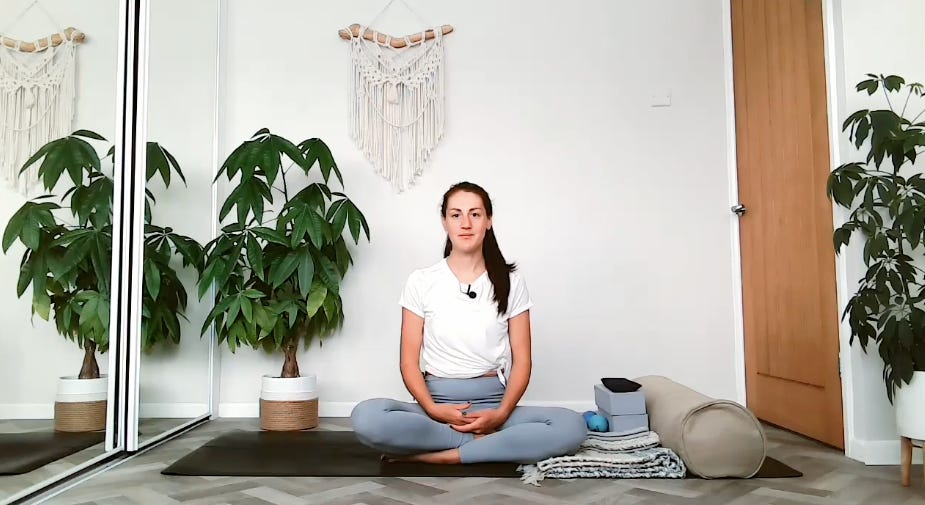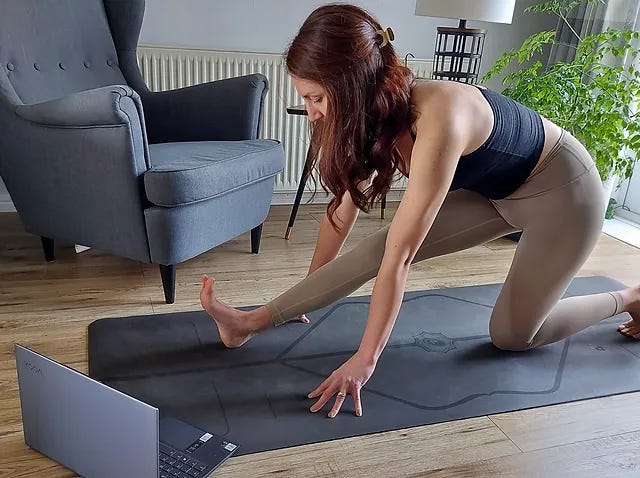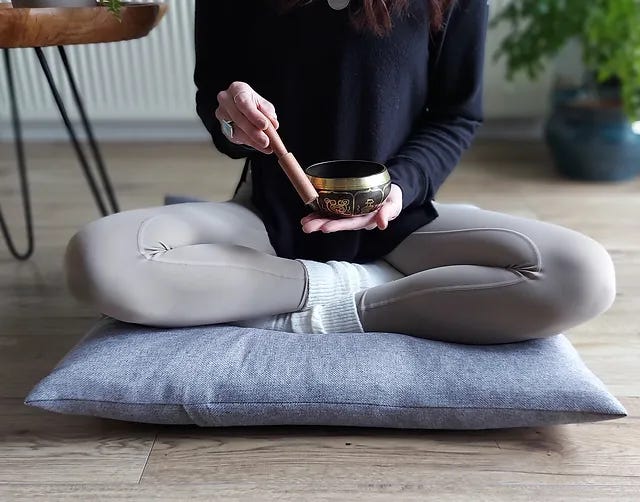We open the week exploring one of the most familiar (but maybe misunderstood) forms of rest - physical rest.
In her book Sacred Rest, Saundra Dalton-Smith says:
Physical rest is “the chance to use the body in restorative ways to decrease muscle tension, reduce headaches, and promote higher quality sleep.”
This is where it can be misunderstood. Sometimes resting is perceived as the absence of doing - like chilling out to watch a movie, for example. While that can be a respite from being on-the-go, it may not be nourishing your body with the deep rest it yearns for.
Giving your body the loving act of physical rest might look like mindful movement, nourishing food, swapping a dynamic form of exercise with something more restorative, body massage (or even massaging your own facial muscles) and more passive forms of physical rest - like a nana-nap or a good night’s sleep.
To talk a little more about physical rest is Katie Winder. You really do meet the best of people through the yoga community and my path crossed with Katie last year as we studied the slower, therapeutic benefits of yoga. Her path to discover the deeper levels of yoga and healing is really inspiring. You can read her thoughts on mindful movement below…
TW: The interview makes reference to mental health and trauma.
Hi Katie. Would you like to introduce yourself to the Restival-goers?
I'm Katie of Katie Winder Yoga, a yoga teacher from Preston with a particular interest in trauma and stress. I teach online classes, as well as in-person classes and events.
What does ‘rest’ mean to you? What is your relationship to rest?
Rest is an opportunity for me to practice self-care. It's the space I create to process my emotions, to connect to my inner knowing and to integrate my truth.
My relationship with rest didn’t begin as a welcome practice. As a trauma survivor left with CPTSD, depression & insomnia, rest was uncomfortable and overwhelming for me. In the beginning, rest looked like frequent naps or deep emotional releases, other times it was more like yoga and meditation.
Now, after a decade of self exploration and healing, rest is a frequent drip-feed with pockets of rest scattered throughout my day. I also take time for deep dives into rest with yin and sound healing.
This time and space allows me to reconnect to my inner resources, to keep me present and grounded.
Each time I choose rest, it's a reminder that I'm worthy of being looked after.
Tell us a bit about slow/mindful movement of the body.
Slow, mindful movement allows us to focus on the present moment, to notice our inner landscape and to detach ourselves from any external 'drama' or behaviors that prevent us from processing our emotions.
When we work mindfully with movement, it helps us to ease us gently towards stillness and to regulate our nervous system. As we settle into yin or restorative practices we are allowing our bodies to connect to what I call the ‘long-term projects’ that are only accessible when the nervous system is in sattva (the ‘rest and digest’ state). Those ‘projects’ might be deeper healing of the emotional self or repair of the physical self. It may also include moments of integration and understanding of ourselves or the world around us.
Our minds and bodies know exactly what we need to repair, heal or grow from, providing the opportunity has been created for it to do so.
What are the benefits of the practice?
They counter-balance the stress placed on our mental, physical & emotional self. It is needed more than ever.
Our daily lives are filled with stress from the moment we awake, the rush to work while juggling the care of children, the pressures of our working life and the constant push to 'do more' right up until we go to bed at night, often then with thoughts about our past day or plans for the day ahead.
The more time we spend in these stress states, the more our bodies rely on stress hormones to get us through our day. The result is chronic stress. We can be oblivious to it, maybe spending months or even years in chronic stress. In stress, we’re not attending to those ‘projects’ of healing, processing emotions in-the-moment or regulating our nervous systems.
Regular practices that invite the nervous system to settle, such as mindful movement, yin or restorative yoga, offer an opportunity for the nervous system to begin to recover from stressors, especially when repeated often.
Physical rest is so important as it allows our bodies to maintain our precious health - it allows the lymphatic system to clear out waste matter, the muscles to repair and for nutrients to be distributed. All of these nourishing acts need a sattvic state, a regulated nervous system.
The more we begin to expand our practice of rest, the more we begin to build an emotional resilience (“energy in motion”) and begin the natural healing and processing within. We expand our “window of tolerance” for this energy in motion (e-motions), and build resilience for other stressors in life - such as grief, big change or loss - as and when they occur.
What brought you to this practice?
My journey with yoga began in my teens. I was drawn to eastern symbols and practices but only dappled in meditation. At the time, I wasn't ready for the healing journey that yoga can provide.
I'd been struggling with depression, suicidal thoughts & self harm for most of my teens and early adult life, I was lost and felt I didn't belong anywhere. It wasn't until my early twenties that I started practicing the physical limb of yoga - it was an inner-knowing that this was the path for me.
After medication & doctors appointments failed to help me, I began researching and reading anything I could to help to understand myself and the world around me. I was able to see my suffering was a result of Complex Post Traumatic Stress Disorder and learned that my nervous system was in a constant survival state.
As a survivor, it was a long journey towards trusting other people, as well as trusting my own judgment, to feel safe both in everyday life and in my own skin.
In the beginning I chased the hard, physical yoga practices, opting for arm balances and anything that pushed myself physically. It resulted in overwhelm and keeping me stuck in that same cycle.
It wasn't until after I'd trained as a yoga teacher and during COVID that I began noticing the benefits of calmer practices. Working from home during this time provided my nervous system to have the break it so needed. I spent a lot of my time in yin and restorative practices and eventually moved to train in these disciplines with Yoga Medicine.
Now, my practice has moved towards trauma-informed yoga and learning to understand my own nervous system - learning how to regulate and sit with my emotions.
What value does mindful movement and physical rest bring you personally?
These practices have been incredibly valuable for me, they have allowed me to feel safe in my body and at peace with myself.
I've developed compassion towards myself and I’m able to look after myself in ways that previously I would have abandoned. I feel comfortable in stillness, I have a good relationship with sleep and I’m able to attend to my basic needs. They have helped me to heal and to accept what I have been through.
The journey towards teaching these practices has been incredibly fulfilling and has shown me the importance of holding safe spaces for others to move along their own journey. It has been incredibly rewarding to have a sense of real purpose.
Tell us about a time when you felt ‘at rest’ in some way.
My perfect rest is pretty simple. I place a high value on the grounding comforts of my home.
A typical day of rest for me would include nourishing foods, woodland walks or pottering around in my garden to connect with nature. It might include a relaxing bath and some restorative yoga.
I'm incredibly creative and find peace when I allow my creativity to flow. Sometimes my days spent resting can inspire creative projects from graphic design to drawing, macramé to painting, or even building furniture. Anything goes!
PRACTICE WITH KATIE: If you’d like to experience a yummy restorative yoga practice from the comfort of your home, Katie has kindly shared a practice especially for Restival-goers. The practice called ‘Inviting Rest’ is available HERE
You can find Katie on Instagram or access her online classes HERE
Comment below to tell us what act of physical rest you’re weaving into your day today? If you’re practicing with Katie, make sure you tag @katiewinderyoga and use #RestRebellion







